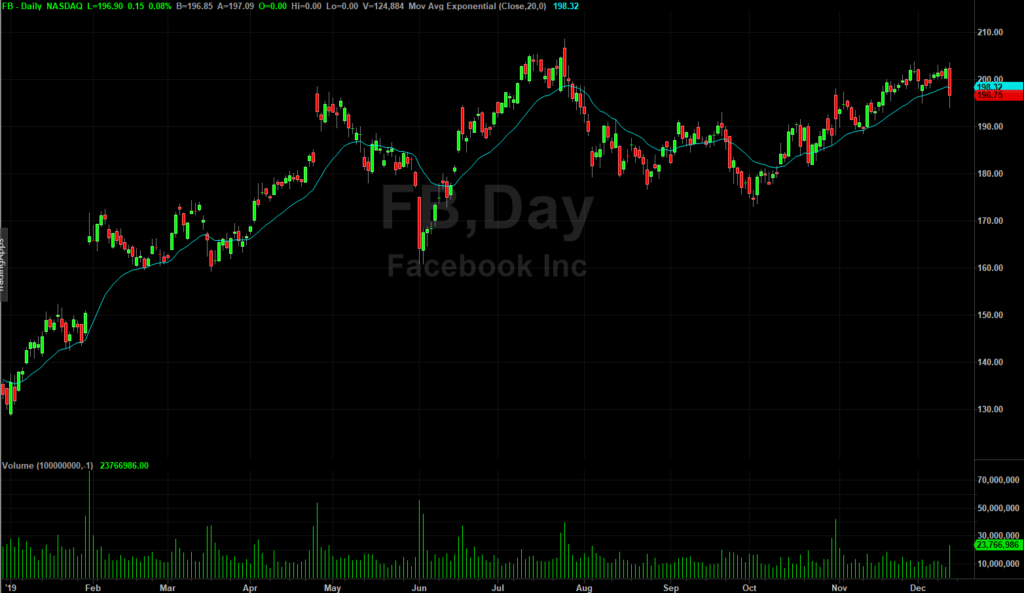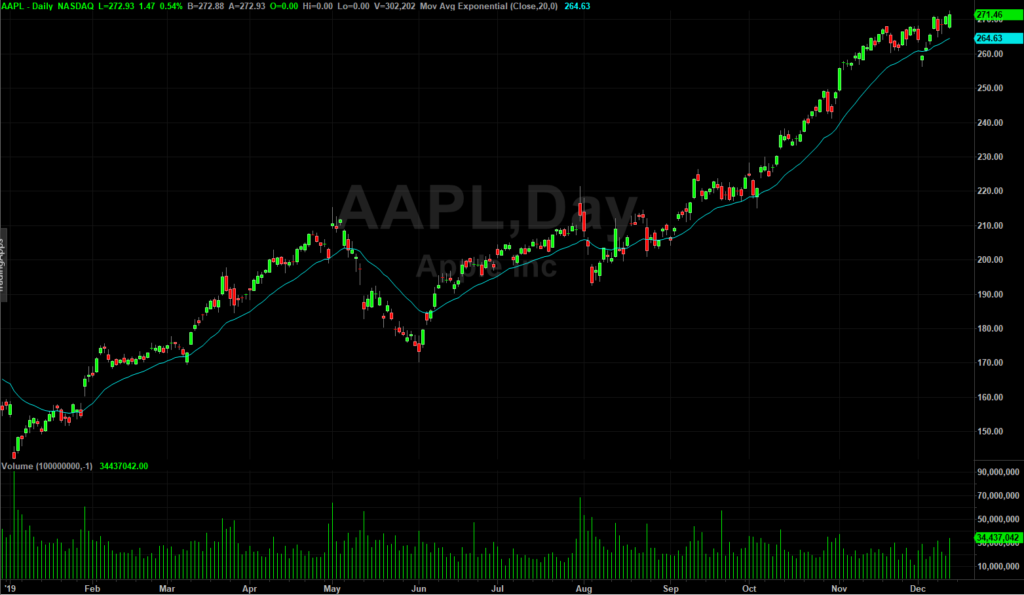FAANG stocks are a basket of some of the largest, most popular public tech companies in the world.
The term “FANG stocks” was coined by Jim Cramer, host of CNBC’s “Mad Money” and the founder of TheStreet.com, in February 2013. It is an acronym for four U.S. tech stocks – Facebook, Amazon.com, Netflix, and Google parent Alphabet.
Apple was unofficially added to the list in 2017 by some Wall Street analysts to create “FAANG.” The common thread that links this group of stocks is that they are very big companies that wouldn’t exist at all in their current state without modern digital technologies.
FAANG stocks currently represent approximately 12.5% of the value of the capitalization-weighted Standard & Poor’s 500 Index. With that in mind, let’s now take a look at where each FAANG stock stands as we move into the new year.
FAANG Stocks Breakdown
Facebook (NASDAQ: FB)
Facebook has remained one of the best-performing FAANG stocks this year, despite the social media giant being at the center of antitrust regulatory investigations and data privacy scandals.
In April, Facebook CEO Mark Zuckerberg admitted during his testimony at Capitol Hill that the company didn’t do enough to prevent its platform from being used by bad elements to spread fake news, hate speech, breach user privacy, and interfere in foreign elections.
The Federal Trade Commission (FTC) slapped Facebook with a record $5 billion fine in July for its role in the Cambridge Analytica scandal. This is the biggest fine the agency has handed down to a tech company since Google’s $22.5 million penalty in 2012 over its privacy practices.
Despite this, Facebook has emerged almost completely unharmed as it continues to rake in billions of dollars in profit selling ad space. Facebook shares have been in a rising channel, rallying more than 53% to just above $200 so far this year.
Amazon (NASDAQ: AMZN)
Amazon shares have underperformed the broader U.S. market in 2019, posting a gain of 16% so far this year against the S&P 500’s gain of 25%. Like Facebook, Amazon has had its own share of problems.
Amazon’s cloud businesses and core e-commerce growth appear to be slowing. In addition, the company has lost the lucrative Joint Enterprise Defense Infrastructure (JEDI) contract to rival Microsoft.
Nonetheless, Amazon is still a potential buy given it regularly breaks holiday sales records and the 2019 holiday season might follow that same route. The e-commerce juggernaut recently revealed that Cyber Monday 2019 was its single biggest shopping day in history. Amazon is projected to generate revenues of $280 billion in 2019.
On top of that, a recent survey shows that nearly 42% of shoppers are expected to do most or all of their holiday shopping on Amazon this year. This means the company is likely to see another record-breaking holiday season that could send its shares higher.
Apple (NASDAQ: AAPL)
Apple – the company that forever changed how people communicate after unveiling the first iPhone in 2007 – has been grappling with a number of challenges in China over the past year.
The trade war between Washington and Beijing has sparked a sense of economic nationalism in China, with local smartphone users favoring Chinese brands such as Huawei.
In addition, its premium smartphones have received a tepid reception in recent years, as people continue to hold onto their phones for longer instead of buying newer models. Furthermore, analysts remain concerned that Apple could find itself at the center of any new round of tit-for-tat tariffs between U.S. and China.
In spite of these hurdles, shares of Apple are up 70% this year. In fact, Apple has been the best performing Dow member by a fairly wide margin in 2019. The surge has pushed Apple’s market cap to well over $1 trillion.
Apple is also widely expected to launch three new iPhones next year that could help it reignite growth and send its shares even higher.
Netflix (NASDAQ: NFLX)
Netflix stock is up more than 11% year to date, underperforming the broader S&P 500. However, the streaming giant has returned a whopping 3,600% to investors in the last ten years, making it one of the best-performing stocks of the decade.
Netflix has remained largely unchallenged by lesser-known streaming services such as Amazon Prime Video, Hulu, Disney+, Apple TV+, NBCUniversal’s Peacock, and HBOMax from AT&T. The Silicon Valley company continues to pour more resources into in its direct-to-consumer model than its rivals.
Nonetheless, Needham analyst Laura Martin predicts Netflix could lose about 4 million U.S. subscribers at its premium priced tier of $9-$16 per month in 2020 amid growing competition in the streaming space.
Alphabet (NASDAQ: GOOGL) (NASDAQ: GOOG)
Shares of Alphabet have risen by as much as 30% from the start of January through December 12, outpacing the broader S&P 500 index. Alphabet consists of various businesses such as search giant Google, YouTube, life sciences company Verily, self-driving car company Waymo, and many others.
Larry Page and Sergey Brin, who founded Google as a research project more than 20 years ago, recently announced their decision to step down from their positions as CEO and president of Alphabet.
The pair said they will remain actively involved as co-founders, board members, and shareholders. Sundar Pichai, the current CEO of Google, retained his job and additionally assumed the role of Alphabet CEO as well.
However, Alphabet’s executive shuffle isn’t likely to have an impact that could weigh on the stock in 2020.
Final Thoughts
Despite offering investors little upside this year, FAANG stocks are a huge part of many portfolios. These stocks have been largely responsible of the stocks market’s gains over the past few years.
As we move into 2020, FAANG stocks are likely to regain their footing and push the stock market higher, especially if the U.S.-China trade spat comes to an end.
Nonetheless, there is no guarantee these companies will not continue to be hurt by antitrust regulations and increased scrutiny on personal data laws.







